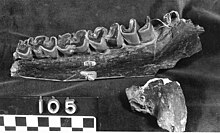Diceratherium
| Diceratherium | |
|---|---|

| |
| Diceratherium skull, University of California Museum of Paleontology | |
Fossil
| |
| Scientific classification | |
| Kingdom: | |
| Phylum: | |
| Class: | |
| Order: | |
| Family: | |
| Genus: | Diceratherium Marsh, 1875
|
| Type species | |
| † Diceratherium armatum Marsh, 1875
| |
| Species[1] | |
| |
Diceratherium is an extinct genus of rhinoceros endemic to North America, Europe, and Asia during the Oligocene through Miocene living from 33.9—11.6 mya, existing for approximately 22.3 million years.[2] Mass estimates for the type species, D. armatum average around 1 t (2,200 lb)[3]
Taxonomy


Diceratherium was named by Marsh (1875). It is not extant. Its type is Diceratherium armatum. It was assigned to Rhinocerotidae by Marsh (1875) and Carroll (1988); to Diceratheriinae by Prothero (1998); to Aceratheriinae by Weidmann and Ginsburg (1999); and to Teleoceratini by Sach and Heizmann (2001).[4][5] Diceratherium had two horns side-by-side on it nose. It lived during the Miocene Epoch.
References
- ^ Prothero, Donald R. (2005). The Evolution of North American Rhinoceroses. Cambridge University Press. p. 228. ISBN 9780521832403.
- ^ PaleoBiology Database: Diceratherium, basic info
- ^ Paleobiology Database. "Diceratherium, morphology". Retrieved 9 January 2013.
- ^ R. L. Carroll. 1988. Vertebrate Paleontology and Evolution. W. H. Freeman and Company, New York 1-698
- ^ V. J. Sach and E. P. J. Heizmann. 2001. Stratigraphy and mammal faunas of the Brackwassermolasse in the surroundings of Ulm (Southwest Germany). Stuttgarter Beiträge zur Naturkunde Serie B (Geologie und Paläontologie) 310:1-95
